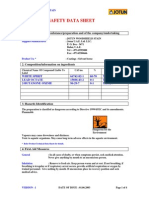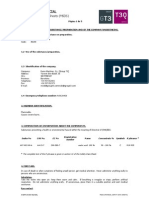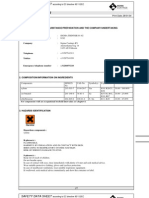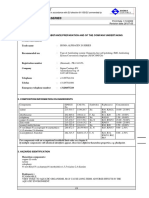0105 Sigma Thinner 20-05
0105 Sigma Thinner 20-05
Uploaded by
ibrahim_mohamed3361Copyright:
Available Formats
0105 Sigma Thinner 20-05
0105 Sigma Thinner 20-05
Uploaded by
ibrahim_mohamed3361Original Description:
Copyright
Available Formats
Share this document
Did you find this document useful?
Is this content inappropriate?
Copyright:
Available Formats
0105 Sigma Thinner 20-05
0105 Sigma Thinner 20-05
Uploaded by
ibrahim_mohamed3361Copyright:
Available Formats
SAFETY DATA SHEET
according to EC directive 93/112/EC
SIGMA THINNER 20-05
Version 1
Print Date Dec 2002
1. IDENTIFICATION OF THE SUBSTANCE/PREPARATION AND THE COMPANY/UNDERTAKING
Product information
Trade name
SIGMA THINNER 20-05
Company
Telephone
Telefax
:
:
Sigma Paints Saudi Arabia Ltd.
P.O. Box 7509
Dammam 31472
+966 3 847 3100
+966 3 847 1734
Emergency telephone number
+966 3 857 2394
2. COMPOSITION/INFORMATION ON INGREDIENTS
Components
NAPHTHA (PETROLEUM),
HYDRODESULFURIZED HEAVY
CAS-No.
64742-82-1
Symbol(s):
Xn, N
R-phrase(s)
R10, R51/53,
R65
Concentration
50.00 - 100.00%
3. HAZARDS IDENTIFICATION
Harmful
Hazardous components :
NAPHTHA (PETROLEUM), HYDRODESULFURIZED HEAVY
R-phrase(s) :
FLAMMABLE.
HARMFUL: MAY CAUSE LUNG DAMAGE IF SWALLOWED.
S-phrase(s) :
If swallowed, do not induce vomiting: seek medical advice immediately and show this container or label.
Do not breathe spray.
In case of insufficient ventilation, wear suitable respiratory equipment.
4. FIRST AID MEASURES
General advice
Eye contact
Skin contact
Inhalation
Ingestion
When symptoms persist or in all cases of doubt seek medical advice. Never
give anything by mouth to an unconscious person.
Irrigate copiously with clean, fresh water for at least 10 minutes, holding the
eyelids apart. Remove contact lenses. Seek medical advice.
Take off all contaminated clothing immediately. Wash skin thoroughly with
soap and water or use recognized skin cleanser. Do NOT use solvents or
thinners.
Remove to fresh air. Keep patient warm and at rest. If breathing is irregular
or stopped, administer artificial respiration. If unconscious place in recovery
position and seek medical advice.
If accidently swallowed obtain immediate medical attention. Keep at rest. Do
not induce vomiting.
1/5
SAFETY DATA SHEET
according to EC directive 93/112/EC
SIGMA THINNER 20-05
Version 1
Print Date Dec 2002
5. FIRE-FIGHTING MEASURES
Specific hazards during fire
fighting
Special protective equipment
for fire-fighters
Suitable extinguishing media
Extinguishing media which
must not be used for safety
reasons
As the product contains cumbustible organic components, fire will produce
dense black smoke containing hazardous products of combustion (see section
10). Exposure to decomposition products may be a hazard to health. Cool
closed containers exposed to fire with water spray. Do not allow run-off from
fire fighting to enter drains or water courses.
In the event of fire, wear self-contained breathing apparatus.
Use water spray, alcohol-resistant foam, dry chemical or carbon dioxide.
Keep containers and surroundings cool with water spray.
Do NOT use water jet.
6. ACCIDENTAL RELEASE MEASURES
Personal precautions
Environmental precautions
Methods for cleaning up
Additional advice
Use personal protective equipment. Ventilate the area. Refer to protective
measures listed in sections 7 and 8. Wear respiratory protection. Beware of
vapours accumulating to form explosive concentrations. Vapours can
accumulate in low areas. Remove all sources of ignition.
Try to prevent the material from entering drains or water courses. If the
product contaminates rivers and lakes or drains inform respective authorities.
Clean with detergents. Avoid solvents. Contain and collect spillage with noncombustible absorbent material, (e.g. sand, earth, diatomaceus earth,
vermiculite) and place in container for disposal according to local / national
regulations (see section 13).
Refer to section 15 for specific national regulation.
7. HANDLING AND STORAGE
Handling
Safe handling advice
Advice on protection against
fire and explosion
Avoid exceeding of the given occupational exposure limits (see section 8).
Use only in area provided with appropriate exhaust ventilation. Avoid contact
with skin, eyes and clothing. Smoking, eating and drinking should be
prohibited in the application area. Avoid inhalation of vapour or mist. For
personal protection see section 8.
Prevent the creation of flammable or explosive concentrations of vapour in
air and avoid vapour concentration higher than the occupational exposure
limits. When transferring from one container to another apply earthing
measures and use conductive hose material. No sparking tools should be
used. The product should only be used in areas from which all naked lights
and other sources of ignition have been excluded. No smoking. The
accumulation of contaminated rags and dry overspray, particularly in spray
booth filters, may result in spontaneous combustion. Good housekeeping
standards, regular safe removal of waste materials and regular maintenance of
spray booth filters will minimise the risks of spontaneous combustion and
other fire hazards.
Storage
Requirements for storage areas
and containers
Observe label precautions. Prevent unauthorized access. Containers which
are opened must be carefully resealed and kept upright to prevent leakage.
Store between 5 and 25C in a dry, well ventilated place away from sources
of heat, ignition and direct sunlight. Solvent vapours are heavier than air and
may spread along floors. Vapours may form explosive mixtures with air.
Electrical installations / working materials must comply with the
technocological safety standards. Keep away from sources of ignition - No
smoking. Store in accordance with the particular national regulations (see
section 15).
2/5
SAFETY DATA SHEET
according to EC directive 93/112/EC
SIGMA THINNER 20-05
Version 1
Advice on common storage
Print Date Dec 2002
Keep away from oxidising agents and strongly acid or alkaline materials.
8. EXPOSURE CONTROLS / PERSONAL PROTECTION
Minimum ventilated air quantity for 1 liter of product
:
209 m3/l
Personal protection advice
Respiratory protection
Hand protection
:
:
Eye protection
Skin and body protection
:
:
Use personal protective equipment. Ventilate the area. Refer to protective
measures listed in sections 7 and 8. Wear respiratory protection. Beware of
vapours accumulating to form explosive concentrations. Vapours can
accumulate in low areas. Remove all sources of ignition.
Provide adequate ventilation.
For prolonged or repeated contact use protective gloves. Barrier creams may
help to protect the exposed areas of skin, they should however not be applied
once exposure has occurred. Skin should be washed after contact.
Chemical resistant goggles must be worn.
Personnel should wear protective clothing. Skin should be washed after
contact.
TO REACH 10 % LEL
Personal protective equipment
9. PHYSICAL AND CHEMICAL PROPERTIES
Form
liquid
Colour
clear
Odour
hydrocarbon-like
Flash point
38 C
Autoignition temperature
> 210 C
Lower explosion limit
0.6 %(V)
Density
0.77 g/cm3
Water solubility
immiscible
Viscosity, dynamic
50 mPa.s at 23 C
Conditions to avoid
Hazardous reactions
Hazardous decomposition
products
Avoid temperatures above 60C, direct sunlight and contact with sources of
heat.
Keep away from oxidising agents, strongly alkaline and strongly acid
materials in order to avoid exothermic reactions.
In case of fire hazardous decomposition products may be produced such as:
Carbon dioxide (CO2), carbon monoxide (CO), oxides of nitrogen (NOx),
dense black smoke.
10. STABILITY AND REACTIVITY
3/5
SAFETY DATA SHEET
according to EC directive 93/112/EC
SIGMA THINNER 20-05
Version 1
Print Date Dec 2002
11. TOXICOLOGICAL INFORMATION
Acute oral toxicity
Acute inhalation toxicity
Skin irritation
Eye contact
Further information
:
:
May cause nausea, abdominal spasms and irritation of the mucous
membranes.
Exposure to component solvent vapours concentration in excess of the stated
occupational exposure limit may result in adverse health effects. Such as:
mucous membrane irritation, respiratory system irritation, adverse effects on
kidney, liver and central nervous system. Symptoms and signs: headache,
dizziness, fatigue, muscular weakness, drowsiness and in extreme cases loss
of consciousness.
Repeated or prolonged contact with the preparation may cause removal of
natural fat from the skin resulting in desiccation of the skin. The product may
be absorbed through the skin.
The liquid splashed in the eyes may cause irritation and reversible damage.
There is no data available for this product.
There is no data available for this product.
The product should not be allowed to enter drains, water courses or the soil.
Disposal together with normal waste is not allowed. Special disposal required
according to local regulations.
12. ECOLOGICAL INFORMATION
Further information
13. DISPOSAL CONSIDERATIONS
Product
14. TRANSPORT INFORMATION
ADR
Class : 3 / 31c
UN-No : 1300
ADR/RID-Labels : 3
Limited Quantities: Max. per inner pack.: 5.00 L - Max. per outer pack.: 45.00 L
Proper shipping name : TURPENTINE SUBSTITUTE
IMDG
Class : 3.3
UN-No : 1300
IMDG labels : 3
EmS : 3-07
MFAG : 311
Marine pollutant : P
IMDG Page : 3375
Packaging group : III
Proper shipping name : TURPENTINE SUBSTITUTE
IATA_C
Class : 3, Sub-risks :
UN-No : 1300
Packaging group : III
Proper shipping name : TURPENTINE SUBSTITUTE
15. REGULATORY INFORMATION
Remarks
A hard copy of the label is placed in section 3
Hazardous components which must be listed on the label:
4/5
SAFETY DATA SHEET
according to EC directive 93/112/EC
SIGMA THINNER 20-05
Version 1
Print Date Dec 2002
NAPHTHA (PETROLEUM), HYDRODESULFURIZED HEAVY
Symbol(s):
Xn
Harmful
R-phrase(s)
R10
R65
Flammable.
Harmful: may cause lung damage if swallowed.
S-phrase(s)
S62
If swallowed, do not induce vomiting: seek medical
advice immediately and show this container or label.
Do not breathe spray.
In case of insufficient ventilation, wear suitable
respiratory equipment.
S23
S38
773 g/l
Method: Calculated
Vlarem
Vlarem 2A
CPR Classification
K2 Xn
NER Classification
NER Class O.1: 0.0 %(m)
NER Class O.2: 0.0 %(m)
NER Class O.3: 100 %(m)
VOC
National legislation
16. OTHER INFORMATION
Explanation of R-phrases mentioned in section 2
NAPHTHA (PETROLEUM),
HYDRODESULFURIZED HEAVY
R10
R51/53
R65
Flammable.
Toxic to aquatic organisms, may cause long-term adverse
effects in the aquatic environment.
Harmful: may cause lung damage if swallowed.
Changes since the last version will be highlighted in the margin. This version replaces all previous versions.
The information contained in this safety data sheet is based on the present state of knowledge and current national
legislation at the date of issue. The company reserves the right to modify data without notice. Any change in data will
normally be followed by issue of a new safety data sheet. The user should check the date of issue and if more than 12
months have elapsed, then the data should only be used after checking with our nearest sales office to establish that
they are still valid. . As the specific conditions of use of the product are outside the suppliers control, the user is
responsible for ensuring that the requirements of relevant legislation are complied with. None of the information
contained in this safety data sheet can be constructed as a guarantee with regard to the properties of the product
described. No liability can be accepted on the basis of this safety data sheet.
After all component(s) stated on the relevant Technical Data Sheet have been mixed the safety precautions mentioned
on each of the component(s) safety data sheets and labels should be used in assessing the safety precautions of the
mixed product.
For further information see technical data sheet number: 0105
5/5
You might also like
- VW01155 - EN - Kasım 2009Document6 pagesVW01155 - EN - Kasım 2009makineci_67No ratings yet
- Hydro X Boiler TreatmentDocument5 pagesHydro X Boiler TreatmentZoran ObradovicNo ratings yet
- SOW - Chemical Injection Skids (Solar) Rev0Document13 pagesSOW - Chemical Injection Skids (Solar) Rev0Aamir Sayeed100% (2)
- Base Line SurveyDocument10 pagesBase Line Surveycisar0007100% (1)
- Pressure Relieving Device Inspection ProcedureDocument2 pagesPressure Relieving Device Inspection Procedurecamasa2011No ratings yet
- Sigma Paints 21-06Document6 pagesSigma Paints 21-06Asela BollegalaNo ratings yet
- Msds Sigma Vikote 14 (Sigmarine Alu Primer)Document7 pagesMsds Sigma Vikote 14 (Sigmarine Alu Primer)kumarNo ratings yet
- Safety Data Sheet: 1. Identification of The Substance/preparation and of The Company/undertakingDocument4 pagesSafety Data Sheet: 1. Identification of The Substance/preparation and of The Company/undertakingBalasubramanian AnanthNo ratings yet
- Msds Sigma Phenguard 935 (Sigma Phenguard Coating) BaseDocument7 pagesMsds Sigma Phenguard 935 (Sigma Phenguard Coating) BasekumarNo ratings yet
- Msds Sigma Phenguard 930 (Sigma Phenguard Primer) BaseDocument7 pagesMsds Sigma Phenguard 930 (Sigma Phenguard Primer) BasekumarNo ratings yet
- Safety Data Sheet: 1. Identification of The Substance/preparation and of The Company/undertakingDocument4 pagesSafety Data Sheet: 1. Identification of The Substance/preparation and of The Company/undertakingBalasubramanian AnanthNo ratings yet
- Safety Data Sheet: 1. Identification of The Substance/preparation and of The Company/undertakingDocument4 pagesSafety Data Sheet: 1. Identification of The Substance/preparation and of The Company/undertakingBalasubramanian AnanthNo ratings yet
- Safety Data Sheet: 1. Identification of The Substance/preparation and of The Company/undertakingDocument4 pagesSafety Data Sheet: 1. Identification of The Substance/preparation and of The Company/undertakingBalasubramanian Ananth100% (1)
- A0200 Acetic Acid Glacial EngDocument5 pagesA0200 Acetic Acid Glacial EngWaqas RamayNo ratings yet
- Sigmadur Semigloss HardenerDocument7 pagesSigmadur Semigloss HardenerSelvakpm06No ratings yet
- PBF MSDS AsphaltDocument11 pagesPBF MSDS AsphaltAgustn LopzNo ratings yet
- Sigma Thinner 91 - 92Document7 pagesSigma Thinner 91 - 92mevansmetreelNo ratings yet
- Msds Sigma Phenguard 930-935-940 (Sigma Phenguard) HardenerDocument8 pagesMsds Sigma Phenguard 930-935-940 (Sigma Phenguard) HardenerkumarNo ratings yet
- Fast Wax MsdsDocument5 pagesFast Wax MsdsAnaditiNo ratings yet
- Car Dip+Spray On+issue+2 1Document6 pagesCar Dip+Spray On+issue+2 1mxsportNo ratings yet
- Msds Sigma Ecofleet 530 (Ecol Ha)Document8 pagesMsds Sigma Ecofleet 530 (Ecol Ha)kumarNo ratings yet
- Durathane Matt - Comp ADocument4 pagesDurathane Matt - Comp ABalasubramanian AnanthNo ratings yet
- Dashboard Cleaner With SiliconeDocument5 pagesDashboard Cleaner With SiliconedimasfebriantoNo ratings yet
- Msds Sigms Alphagen 650Document8 pagesMsds Sigms Alphagen 650kumarNo ratings yet
- Safety Data Sheet: 1. Identification of The Substance/preparation and of The Company/undertakingDocument4 pagesSafety Data Sheet: 1. Identification of The Substance/preparation and of The Company/undertakingBalasubramanian AnanthNo ratings yet
- Hempalin Enamel 5214000030 En-UsDocument9 pagesHempalin Enamel 5214000030 En-UszayzanNo ratings yet
- MSDSDocument6 pagesMSDSMuhammad Iqbal NiyaziNo ratings yet
- Msds Sigmadur 520-550 HardenerDocument7 pagesMsds Sigmadur 520-550 HardenereternalkhutNo ratings yet
- MSDSDocument4 pagesMSDSRehan SadiqNo ratings yet
- Msds Sigma Alphagen 50 SeriesDocument8 pagesMsds Sigma Alphagen 50 SerieskumarNo ratings yet
- Safety Data Sheet: Spotcheck SKC-S - AerosolDocument6 pagesSafety Data Sheet: Spotcheck SKC-S - AerosolChandrasekhar SonarNo ratings yet
- 770 MSDSDocument6 pages770 MSDSAhmed Emad AhmedNo ratings yet
- Msds Eurokyd Bs36 Tx60Document4 pagesMsds Eurokyd Bs36 Tx60roybombomNo ratings yet
- Gas-Glo 32 SDS En-UsDocument5 pagesGas-Glo 32 SDS En-UsLimosh BsNo ratings yet
- 3307 SIGMA C200a COALTAR EPOXY HARDENERDocument8 pages3307 SIGMA C200a COALTAR EPOXY HARDENERusman khalidNo ratings yet
- Preslia GT 46Document6 pagesPreslia GT 46muktiNo ratings yet
- Msds Sigma Alphagen 20 SeriesDocument8 pagesMsds Sigma Alphagen 20 SerieskumarNo ratings yet
- Msds Thinner 76 PDFDocument5 pagesMsds Thinner 76 PDFRameshNo ratings yet
- MSDS - GP Care Handsanitizer Alcohol BasedDocument6 pagesMSDS - GP Care Handsanitizer Alcohol Based012321010No ratings yet
- MSDS Hno3Document8 pagesMSDS Hno3Niko Sam SoonNo ratings yet
- 8018 MsdsDocument6 pages8018 MsdsAhmed Emad AhmedNo ratings yet
- KRG - MSDS For AmmoniaDocument4 pagesKRG - MSDS For AmmoniaAbdulSamadNo ratings yet
- Scale Inhibitor - Gyptron IT-265 - MSDS - ENGDocument5 pagesScale Inhibitor - Gyptron IT-265 - MSDS - ENGTHANGVUNo ratings yet
- Loctite Solvo-Rust Super Penetrating Oil AerosolDocument4 pagesLoctite Solvo-Rust Super Penetrating Oil AerosolPaul Christian Rojas FloresNo ratings yet
- 1250 Red MSDSDocument4 pages1250 Red MSDSkwerwaNo ratings yet
- Sodium Met A Period AteDocument6 pagesSodium Met A Period AteFina Mustika SimanjuntakNo ratings yet
- Safety Data Sheet: Identification of The Substance/Preparation and of The Company/Undertaking 1Document13 pagesSafety Data Sheet: Identification of The Substance/Preparation and of The Company/Undertaking 1Chan Shiaw SyanNo ratings yet
- SDS - Durosan - English (Uk) - DubaiDocument5 pagesSDS - Durosan - English (Uk) - DubaiBalasubramanian AnanthNo ratings yet
- 1250 White Sds PDFDocument4 pages1250 White Sds PDFkwerwaNo ratings yet
- Na HSO3Document8 pagesNa HSO3Bao Duy NguyenNo ratings yet
- Msds Sigma Vikote 56 (Sigma Topacryl Finish) (Chrome)Document8 pagesMsds Sigma Vikote 56 (Sigma Topacryl Finish) (Chrome)kumarNo ratings yet
- Diesel Msds ReportDocument0 pagesDiesel Msds ReportsahilchemNo ratings yet
- SDS - Aluminium Paint H.R. - Marine - Protective - English (Uk) - SingaporeDocument6 pagesSDS - Aluminium Paint H.R. - Marine - Protective - English (Uk) - SingaporeAmi Terecef Gamboa MirandaNo ratings yet
- Isopar HDocument11 pagesIsopar Hwaxim26322No ratings yet
- 3307 Sigma C200A Coal Tar EpoxyDocument3 pages3307 Sigma C200A Coal Tar Epoxyusman khalidNo ratings yet
- MSDS AlumDocument5 pagesMSDS Alumdhinda clariestaNo ratings yet
- Asphalt MSDSDocument8 pagesAsphalt MSDSJunard M. Lu HapNo ratings yet
- Quartz 5000 SN 15w-50-MsdsDocument6 pagesQuartz 5000 SN 15w-50-MsdsAlkinson CecilNo ratings yet
- Diesel Fuel MsdsDocument10 pagesDiesel Fuel Msdsrongo84No ratings yet
- POLYPOL 1015 Jan 2013Document7 pagesPOLYPOL 1015 Jan 2013assam rebbatNo ratings yet
- Dust Explosion and Fire Prevention Handbook: A Guide to Good Industry PracticesFrom EverandDust Explosion and Fire Prevention Handbook: A Guide to Good Industry PracticesNo ratings yet
- After a Disaster - Information to Help You and Your Family RecoverFrom EverandAfter a Disaster - Information to Help You and Your Family RecoverNo ratings yet
- Workplace Vocabulary for Esl Students: With Exercises and TestsFrom EverandWorkplace Vocabulary for Esl Students: With Exercises and TestsNo ratings yet
- PM8909Document1 pagePM8909Ranga SwamyNo ratings yet
- Bentley Instrumentation and Wiring Fundamentals V8i TRN 010330 10002 PDFDocument206 pagesBentley Instrumentation and Wiring Fundamentals V8i TRN 010330 10002 PDFercabamaNo ratings yet
- Safety Data Sheet: Chemical Name Cas # Percent Classification NoteDocument6 pagesSafety Data Sheet: Chemical Name Cas # Percent Classification NoteZainul Abedin SayedNo ratings yet
- Ex34063 PDFDocument1 pageEx34063 PDFLeahNo ratings yet
- TDS Interzinc 2265Document4 pagesTDS Interzinc 2265Veva Santi DNo ratings yet
- Penguard Clear SealerDocument4 pagesPenguard Clear SealerInaam Ullah MughalNo ratings yet
- 1N4148 Diode Pinout, Equivalents, Characteristics & DatasheetDocument3 pages1N4148 Diode Pinout, Equivalents, Characteristics & DatasheetmanguesNo ratings yet
- VPM2SMDocument1 pageVPM2SMdgreparos12No ratings yet
- MSDS 245faDocument5 pagesMSDS 245faShelin Mitra Megamas IndonesiaNo ratings yet
- Functional Specification For Deck CraneDocument31 pagesFunctional Specification For Deck Craneaiyubi20% (1)
- Belt Conveyor Scale DataSheetDocument3 pagesBelt Conveyor Scale DataSheetBalu Sukumar100% (1)
- (Signed) OCD-CTC2-TR-2.33B - 0 - TR For Distribution TransformerDocument11 pages(Signed) OCD-CTC2-TR-2.33B - 0 - TR For Distribution TransformerNhut Bang NguyenNo ratings yet
- International Interswift 6800HS Antifouling Product Data SheetDocument4 pagesInternational Interswift 6800HS Antifouling Product Data Sheetadul sungkatinNo ratings yet
- Hardtop Flexi Technical Data SheetDocument5 pagesHardtop Flexi Technical Data SheetGurdeep Sungh AroraNo ratings yet
- Concure A99 TDSDocument2 pagesConcure A99 TDSchillerz69No ratings yet
- R Series RD4 FlexDocument8 pagesR Series RD4 FlexskumarNo ratings yet
- A4. Drainage Design 2Document54 pagesA4. Drainage Design 2DARSHANKUMAR VORANo ratings yet
- P6550 Technical-Documentation EngDocument72 pagesP6550 Technical-Documentation EngBragutaAlexandruNo ratings yet
- 01 - PTB - Data - Sheet (5 Files Merged) (13 Files Merged)Document27 pages01 - PTB - Data - Sheet (5 Files Merged) (13 Files Merged)bzivkovicNo ratings yet
- NE20E-S Series Low-Speed Line Cards Data Sheet PDFDocument11 pagesNE20E-S Series Low-Speed Line Cards Data Sheet PDFFlávio AraújoNo ratings yet
- Motion Control Lexium 23 PlusDocument23 pagesMotion Control Lexium 23 Plusoswaldo bohorquezNo ratings yet
- Tds 10110030 en en Weicon-CbcDocument1 pageTds 10110030 en en Weicon-CbcKJ SupplyNo ratings yet
- Piping Specialties Rev 4Document25 pagesPiping Specialties Rev 4gigiphi100% (1)
- Cristalactiv™ Pc105: Ultrafine & Specialty Tio ProductsDocument3 pagesCristalactiv™ Pc105: Ultrafine & Specialty Tio ProductsShweta MahajanNo ratings yet
- CZ120 (CW612N) : Technical DatasheetDocument1 pageCZ120 (CW612N) : Technical DatasheetAmrut KanungoNo ratings yet
- Isa-98.00.02 Skill Standards For Control Systems TechniciansDocument22 pagesIsa-98.00.02 Skill Standards For Control Systems TechniciansDalamagas KwnstantinosNo ratings yet

























































































